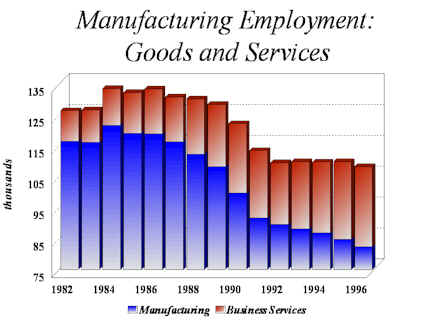|
|
TIME FOR A NEW LOOK AT MANUFACTURING
AND HIGH-TECH
The Providence
Business News, May, 1997
How far has Rhode Island's manufacturing employment base fallen? What must we do to
maintain a stable employment base in manufacturing? Other than the silly topic of whether
manufacturing here is dead or alive, these are the two questions that are discussed most
frequently. Everyone seems willing to venture answers to these questions. I find it
intriguing that even the most influential persons in this state, those who directly
influence policy, continue to approach these with a "traditional" perspective
that lost its relevance ten years ago when Rhode Island became a service and
information-based economy. If we are to meaningfully assess the performance of Rhode
Island's manufacturing sector, we must begin to address questions such as these with a
"non-traditional" perspective.
As a first step in this process, it is necessary to question the viability of the
existing employment classifications upon which our assessments of manufacturing employment
are based. The Standard Industrial Classification (SIC) code categorizes employment by a
series of two, three and four-digit breakdowns. As anyone familiar with SIC codes will
attest, the amount of detail allowed for the manufacturing sector is noticeably greater
than for the service sector. This shouldn't come as much of a surprise since these
classifications were formulated during our nation's manufacturing era, as the
"Industrial" in SIC name code attests. But, while these classifications may have
served us well during the manufacturing era, today they are showing signs of age.
Should we limit our classification of manufacturing activity exclusively to
"goods"? If we do, then the existing "wisdom" on the performance of
our manufacturing sector is valid. Let me argue that we must be more realistic and extend
the definition of manufacturing activity to include both goods and services.
Manufacturers produce both final goods for consumers and inputs for other firms. Just
as this classification is not restricted to "final goods," we need to extend the
definition of "manufactured inputs" to include both goods and services. Today,
manufacturing firms that utilize computer inputs tend to rely far more on personal
computers than on mainframes. So, to produce its product, a hypothetical firm might use
processed steel as an input, which is classified as "manufactured" along with
data processing and computer programming services which are listed under the SIC category
"Business Services." Can we manufacture services? I believe we can. Business
services should be viewed as a valid form of production. The importance of this should be
obvious: an increasing part of the wealth generated during the "information age"
is related to the creation and processing of data.
If we broaden the definition of manufacturing to include the production of both goods  and services, then, the
trend in Rhode Island manufacturing employment is very different from what is commonly
believed. For well over a decade, the number of jobs in manufacturing has been falling
while business service employment has been rising. The result, as the graph shows, is that
"Manufacturing Goods and Services" employment has remained constant throughout
this entire recovery. and services, then, the
trend in Rhode Island manufacturing employment is very different from what is commonly
believed. For well over a decade, the number of jobs in manufacturing has been falling
while business service employment has been rising. The result, as the graph shows, is that
"Manufacturing Goods and Services" employment has remained constant throughout
this entire recovery.
This brings me to the second question I posed, concerning the requirements for
maintaining a stable manufacturing employment base. Ironically, some manufacturing
employees, those employed by "temp" agencies, are classified under business
services. As a result, we don't know the actual number of manufacturing employees in Rhode
Island. We therefore don't know when manufacturing employment peaked, how much
manufacturing employment has fallen since that peak, or the manufacturing job change since
the present recovery began. What we do know is that in our present low-inflation climate,
manufacturing firms must cut costs to remain competitive. This has compelled surviving
firms to incorporate labor-saving technology into production, which, as its name implies,
has reduced our manufacturing employment base. So, the "good old days" are truly
gone: to maintain a stable manufacturing employment base, it is no longer enough to retain
the same number of manufacturing firms. We need existing firms to expand and new firms to
locate here.
This reclassification of manufacturing activity has important implications for public
policy. High tech services and manufacturing must no longer be viewed as distinct or
mutually exclusive. Policy recommendations should encourage both areas simultaneously.
Just as roads and bridges provide "external economies" for businesses, which has
historically provided a justification for public investment in this area, knowledge and
technology also generate external economies. We should no longer make separate sets of
policy recommendations for manufacturing and "high tech." Instead, this pair
should be viewed as our primary "cluster."
by Leonard Lardaro |